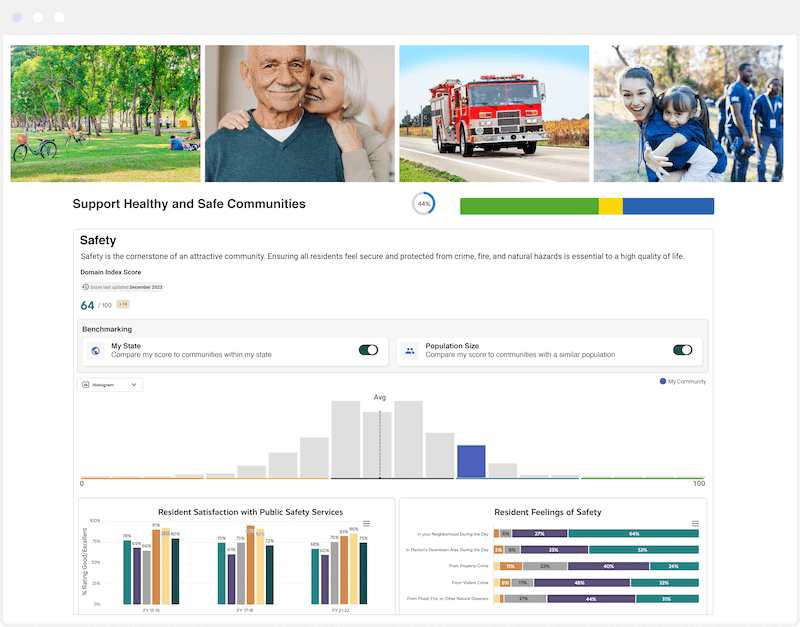Contents
- 1. Involve employees in the planning process
- 2. Assign owners & progress reporting deadlines
- 3. Lead by example
- 4. Build strategy into employee annual work plans and performance assessments
- 5. Link budget requests to strategy
- 6. Use progress reports in team meetings
- 7. Celebrate success
- 8. Make progress public
- 9. Explain the “why”
We’ve supported hundreds of public sector organizations in driving positive change through the implementation of strategic plans. Those that are most successful put a focus on engaging staff at the beginning of the strategic planning process. These are often the same organizations that later weave strategic priorities into budgeting processes, team meetings, and day-to-day employee activities.
However, you can still successfully build staff engagement and buy-in, even with an existing plan.
Here are some of the best ways to engage your employees and inspire action, whether you’re creating a new strategic plan or implementing an existing one.
1. Involve employees in the planning process
Getting staff involved in your planning process is one of the most effective ways to build early buy-in with your strategic plan.
Every department should be involved in creating the action steps and performance measures that roll-up to support the key outcomes of the plan.
The City of Maplewood did a great job of this when creating their strategic plan. Using a community-wide survey as the starting point, the city management team held extensive planning meetings with 6 department heads, 40 supervisors and many of the city’s 170 full-time employees.
2. Assign owners & progress reporting deadlines
Ensure that all of your goals, strategies, actions and performance measures have owners. This is a single person that is responsible for the execution of that activity or for hitting a specific performance target.
Each owner is also responsible for providing monthly or quarterly progress updates on whatever cadence is appropriate. Check out our performance reporting framework for examples.
Having a strategy execution platform, such as Envisio, can be helpful in ensuring that progress updates are submitted on time. The software sends out automated reminders to each goal, strategy, action and measure owner when updates are due. Remember to set the reminder date at least a few days before you plan to send out your overall strategic plan progress report.
Ideally, you would also assign contributors and observers to individual plan elements to further build collaboration and visibility into your plan.
3. Lead by example
When it comes to getting staff buy-in, it’s hard to overstate the importance of having engaged and prepared leaders.
We’ve found that there are three leadership roles critical to the success of your plan—the executive sponsor, the project manager, and the facilitator.
The Executive Sponsor sets the tone by making strategy a priority and using the work done by staff to inform decisions.
The Project Manager is responsible for the successful implementation of the plan and its actions. They are responsible for building relationships with the plan element owners and contributors and overseeing the operations of the plan. The Project Manager ensures all actions have start and end dates, creates the reporting schedule, and ensures measures are quantifiable and actionable.
Facilitators are usually external to the organization and help to design and develop your strategic planning process. The right facilitator will help you to engage and coach staff so your strategic plan does more than simply sit on a shelf.
For more on this topic, read 3 Leadership Roles Key to Successfully Implementing Your Strategic Plan.
4. Build strategy into employee annual work plans and performance assessments
Directly tying individual employee performance goals to the strategic objectives of the organization is a great way to engage employees and put strategy at the heart of operations.
However, doing this effectively often requires a change to the way employee performance reviews and annual work plans are constructed. Making the shift from broadly defined (and evaluated) employee performance to include more goal or task-specific accomplishments can help staff feel better aligned with the overall success of the organization while improving engagement.
5. Link budget requests to strategy
During budget season, make sure your team members know to tie budget requests to a strategic goal. Connecting budget to strategy in this way provides focus for all employees on what is most important and a shared understanding of how you are going to achieve it.
In practical terms, you will need to ensure that your strategic goals/priorities cascade down to action plans that have tasks, milestones and performance measures included. Budget is then tied to specific actions which are aligned with an overarching strategic goal.
For a deeper dive on this topic, check out Does Your Budget Support Your Strategy? 3 Things You May Be Missing.
6. Use progress reports in team meetings
As discussed, team members should be able to link their day-to-day actions back to strategy. To reinforce this, we recommend regularly using progress reports to frame discussions during team meetings.
7. Celebrate success
Recognizing success, and building excitement for what’s to come, are important ways to keep your strategic plan top of mind for employees. This is particularly true for plans that span multiple years.
Many of our customers use the reporting feature of Envisio to generate reports such as “what’s been completed this year?” or “what’s scheduled to start next month”. These reports can then be used to call out individuals or teams for their accomplishments, and provide high-level updates to the organization on what comes next. You could use an internal newsletter, intranet, formal recognition program, and/or more informal methods to accomplish this.
8. Make progress public
For public sector and nonprofit organizations, there are many benefits to publicly sharing progress made against a strategic plan. Not only does it help in building trust with external stakeholders, it also provides an additional layer of accountability and engagement for staff.
We recommend sharing plan progress via a public dashboard. Publishing results externally helps staff to recognize the importance of their work and take pride in their contribution.
9. Explain the “why”
Your staff need to understand why your strategic plan—and their role in it —matters. Spend time explaining/revisiting the “why” behind the work, and building excitement for outcomes, and you’ll be in good shape to build an engaged, high-performing team and to successfully implement your strategic plan.
For more help putting your strategic plan into action, check out our Strategic Plan Implementation Guide.




